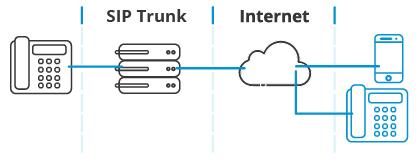Introduction to SIP
In the realm of modern telecommunications, Session Initiation Protocol (SIP) stands as a cornerstone technology, facilitating the initiation, modification, and termination of communication sessions over IP networks. Whether it’s voice calls, video conferencing, or instant messaging, sip trunk serves as the protocol of choice for enabling real-time communication services over the internet.
2. How SIP Works
At its core, SIP operates as a signaling protocol, responsible for initiating, modifying, and terminating multimedia sessions between users. These sessions could entail various forms of communication, including voice, video, messaging, and gaming. SIP employs a request-response model similar to HTTP, where clients initiate sessions by sending SIP requests to servers, which then respond accordingly to establish and manage the session.
3. SIP Components and Architecture
SIP’s architecture comprises several key components, including User Agents (UA), Proxy Servers, Redirect Servers, and Registrar Servers. User Agents function as endpoints in the communication process, while Proxy Servers facilitate routing and forwarding of SIP requests. Redirect Servers provide clients with information about the next hop for their requests, and Registrar Servers maintain a registry of user locations.
4. SIP Trunking: Enhancing Communication
SIP trunking represents a significant evolution in telecommunications, offering businesses a cost-effective and flexible solution for managing their communication needs. Traditionally, organizations relied on physical phone lines or Primary Rate Interfaces (PRIs) to connect their Private Branch Exchange (PBX) systems to the Public Switched Telephone Network (PSTN). However, SIP trunking leverages internet connections to establish virtual connections between the PBX and the PSTN, eliminating the need for dedicated physical lines.
5. Advantages of SIP Trunking
The adoption of SIP trunking brings forth a multitude of benefits for businesses:
- Cost Savings: SIP trunking reduces communication expenses by eliminating the need for multiple PRI lines and associated hardware.
- Scalability: SIP trunks can be easily scaled up or down to accommodate fluctuating call volumes, providing businesses with greater flexibility.
- Enhanced Features: SIP trunking enables access to advanced communication features such as HD voice, video conferencing, and unified communications.
- Geographical Flexibility: With SIP trunking, businesses can establish virtual phone numbers from different geographic locations, enhancing their global presence.
- Disaster Recovery: SIP trunking offers built-in redundancy and disaster recovery capabilities, ensuring business continuity in the event of network outages or natural disasters.
6. Challenges and Considerations
Despite its numerous advantages, SIP trunking also presents certain challenges and considerations for businesses:
- Security Concerns: SIP trunks are susceptible to security threats such as toll fraud, denial-of-service (DoS) attacks, and eavesdropping, necessitating robust security measures.
- Quality of Service (QoS): Maintaining consistent QoS can be challenging over shared internet connections, leading to potential issues with call quality and reliability.
- Interoperability: Ensuring interoperability between different SIP trunk providers and PBX systems requires careful configuration and testing.
- Regulatory Compliance: Businesses must navigate regulatory requirements and compliance standards when deploying SIP trunking services, particularly in industries with stringent data protection regulations.
7. Future of SIP
As technology continues to evolve, the future of SIP holds promise for further innovation and advancement ebook writing dubai. Emerging trends such as Web Real-Time Communication (WebRTC), Internet of Things (IoT) integration, and 5G connectivity are poised to shape the landscape of real-time communication, offering new opportunities for SIP to extend its reach and capabilities.
8. Conclusion
In conclusion, Session Initiation Protocol (SIP) serves as a foundational technology in modern telecommunications, enabling the seamless exchange of multimedia communication over IP networks. With the advent of SIP trunking, businesses can leverage the power of SIP to streamline their communication infrastructure, realizing cost savings, scalability, and enhanced features. While SIP presents certain challenges, its benefits far outweigh the drawbacks, positioning it as a vital component in the future of communication technology.



